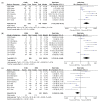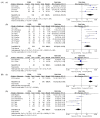Effectiveness of Percutaneous Nephrolithotomy, Retrograde Intrarenal Surgery, and Extracorporeal Shock Wave Lithotripsy for Treatment of Renal Stones: A Systematic Review and Meta-Analysis
- PMID: 33396839
- PMCID: PMC7823824
- DOI: 10.3390/medicina57010026
Effectiveness of Percutaneous Nephrolithotomy, Retrograde Intrarenal Surgery, and Extracorporeal Shock Wave Lithotripsy for Treatment of Renal Stones: A Systematic Review and Meta-Analysis
Abstract
Background and objectives: To perform a updated systematic review and meta-analysis comparing effectiveness of percutaneous nephrolithotomy (PCNL), retrograde intrarenal surgery (RIRS), and extracorporeal shock wave lithotripsy (ESWL) for treatment of renal stones (RS). Materials and Methods: A total of 37 studies were included in this systematic review and meta-analysis about effectiveness to treat RS. Endpoints were stone-free rates (SFR), incidence of auxiliary procedure, retreatment, and complications. We also conducted a sub-analysis of ≥2 cm stones. Results: First, PCNL had the highest SFR than others regardless of stone sizes and RIRS showed a higher SFR than ESWL in <2 cm stones. Second, auxiliary procedures were higher in ESWL than others, and it did not differ between PCNL and RIRS. Finally, in <2 cm stones, the retreatment rate of ESWL was higher than others. RIRS required significantly more retreatment procedures than PCNL in ≥2 cm stones. Complication was higher in PCNL than others, but there was no statistically significant difference in complications between RIRS and PCNL in ≥2 cm stones. For ≥2 cm stones, PCNL had the highest SFR, and auxiliary procedures and retreatment rates were significantly lower than others. Conclusions: We suggest that PCNL is a safe and effective treatment, especially for large RS.
Keywords: extracorporeal shock wave lithotripsy (SWL); percutaneous nephrolithotomy (PCNL); retrograde intrarenal surgery (RIRS); urolithiasis.
Conflict of interest statement
The authors report no conflicts of interest in relation to this work.
Figures















References
-
- Zhang W., Zhou T., Wu T., Gao X., Peng Y., Xu C., Chen Q., Song R., Sun Y. Retrograde Intrarenal Surgery Versus Percutaneous Nephrolithotomy Versus Extracorporeal Shockwave Lithotripsy for Treatment of Lower Pole Renal Stones: A Meta-Analysis and Systematic Review. J. Endourol. 2015;29:745–759. doi: 10.1089/end.2014.0799. - DOI - PubMed
-
- Jung H.D., Kim J.C., Ahn H.K., Kwon J.H., Han K., Han W.K., Kim M.D., Lee J.Y. Real-time simultaneous endoscopic combined intrarenal surgery with intermediate-supine position: Washout mechanism and transport technique. Investig. Clin. Urol. 2018;59:348–354. doi: 10.4111/icu.2018.59.5.348. - DOI - PMC - PubMed
Publication types
MeSH terms
LinkOut - more resources
Full Text Sources
Medical

